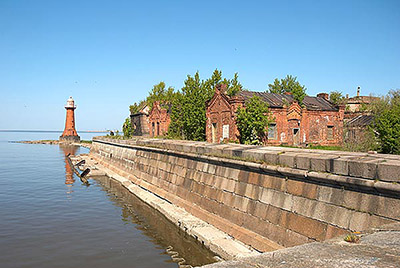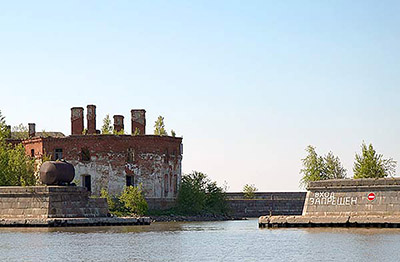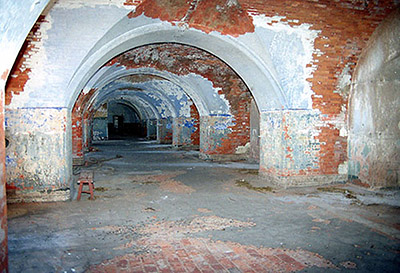 |
Kronshlot
Kronstadt, Russia
|
|
 |
Constructed: 1703-1704,
1717-1724, 1783-1789,
1850-1863
Used by: Russia
Conflict in which it participated:
Great Northern War
|
The Great Northern War (1700-1721) pitted Sweden, semi-undisputed ruler of much of northern Europe at the start of the 18th century, against just about every other northern European state. These belligerents included Great Britain, which actually wound up fighting on both sides of this conflict, though not simultaneously.
|
 |
|
|
Poised to benefit the most from a Swedish fall from grace was Imperial Russia, headed by Peter the Great (1672-1725). Russia wrested what would become Mr. Great's namesake city, Saint Petersburg, from the Swedes in 1703, and wasted no time in getting started on fortification.
|
The Russian fortified water-city Kronstadt by French artist Miné (who may not have actually seen what he was assigned to draw), mid-19th century. Kronshlot is in the direct center, marked 'B'. All those little mini-forts weren't really this close together, although that would have made for an exceedingly difficult nut to crack for Russia's naval enemies. Click on it, it's huge. |
 |
Russia's Starfort Numero Uno, Peter and Paul Fortress, was built at Saint Petersburg starting in 1703. That same year, construction on the first iteration of Kronshlot commenced. Swiss-Italian architect Domenico Trezzini (1670-1734) was a favorite of King Peter, and had contributed to several of Saint Petersburg's important construction projects, including Peter and Paul Fortress. Trezzini was tasked with essentially creating an island in Neva Bay, upon which a fort (designed by the Great Peter) would be built to control the few deepwater channels that an oceangoing ship would need to navigate to get to Saint Petersburg. The Gulf of Finland, which is the body of water we're discussing here, freezes over in winter. The island atop which Kronshlot was built was accomplished by dumping rocks into a hole in the ice! |
|
Two thousand Russian soldiers and cavalrymen, otherwise unoccupied and happy to dump rocks into the water for their king, led horses across the ice, dragging ryazhi, house-sized timber boxes filled with stones. These rockboxes were tipped into the water through a strategically placed hole in the ice, and splash glugluglug, there's your man-made island!
|
For all that work with the rock dumping, the structure that constituted the first iteration of Kronshlot sounds pretty insubstantial: A 36-meter-tall, three-story wooden tower with 46 relatively small guns sticking out of it.
Insubstantial or not, this early version of a Martello Tower played a role in defying a Swedish fleet of eight frigates and some smaller vessels, in June of 1704. The Swedish fleet traded shots at extreme range with Kronshlot and five Russian ships for two days, but nobody actually hit anything, and the Swedes, embarrassed, sailed away unvictorious.
|
 |
 Kronshlot's southwest corner. Kronshlot's southwest corner. |
|
A larger Swedish fleet returned in June of 1705, bent on getting at Saint Petersburg. Kronshlot's firepower had been augmented by a couple of land batteries armed with naval guns, and after a week of what is described as "battle" but seems more like a bunch of guys ineffectually shooting at and missing each other for six days, the Swedish Navy again gave up and sailed away.
|
 Kronshlot's entire length, as seen from the north. Kronshlot's entire length, as seen from the north. |
|
While these inept artillery duels sound pretty hilarious, they at least served to illustrate that the method by which Kronshlot's guns were mounted was impractical...sure the "fort" and assisting Russian ships saw the Swedes off, but you generally want your fort-mounted guns to be able to hit something.
|
 The entrance to Kronshlot's mini-harbor: No Trespass!
|
 |
Kronshlot was given a facelift from 1717 to 1724, during which the fort's guns were placed in a more conventional manner. The adorable mini-harbor that we see today was added during this period. The ridiculous wooden tower was dismantled in 1749. By the end of the 18th century Kronshlot became an actual starfort, with granite walls and pointy bastions, mounting 120 "large calibre" cannon...which were all severely damaged by flooding in 1824.
By this time, Kronstadt was a big ole fortification itself, and no fewer than eight more fortlets on man-made islands had sprouted up in the immediate vicinity...but Kronshlot had been the first.
|
|
Casematemania held the fortification world in its thrall in the mid-19th century. Not wanting to miss out on the latest trend (lest it be dissed by its peers), Kronshlot was upgraded with a two-level, casemated battery along its western face from 1850 to 1863. This battery mounted 11" guns, which at the time were pretty darned huge.
|
The Crimean War (1853-1856) brought with it a threat to Saint Petersburg by the always-scary British Navy. To defend against this, Russia pioneered the art of the modern minefield, stringing mines across the deepwater channel.
An Anglo-French fleet appeared off of Kronstadt in June of 1854, eyeballed things, and left without firing a shot...Kronstadt and its surrounding fortlets must have been a pretty bristly-looking proposition at the time! The British-French fleet returned in the Spring of 1855, this time poking in close enough to sustain some damage from the aforementioned mines, whereupon they again turned tail and departed: Yet another state-of-the-art, up-to-no-good naval force is foiled by Russia!
|
 |
 Starforts are all different, but casemates are all the same. |
|
By the end of the 19th century, huge, modern Krupp guns were mounted on Kronstadt, making all of its surrounding fortlets obsolete. Kronshlot was removed from frontline service in 1896, demoted to the status of ammunition storage facility. Anti-aircraft guns were installed on Kronshlot during the Second World War (1939-1945), and some of the troops defending Kronstadt were stationed there.
Today, Kronshlot is the best-maintained of Kronstadt's fortlings, as it still houses a government demagnetization station: НЕТ ВТОРЖЕНИИ!
Many thanks to Vitaly Pisareff for leading me to this amazing starfort! I always thought there had to be lots more Russian starforts that I was just too dumb to find, and Vitaly proved that to be the case!
|
|
|
|
|
|
 |




